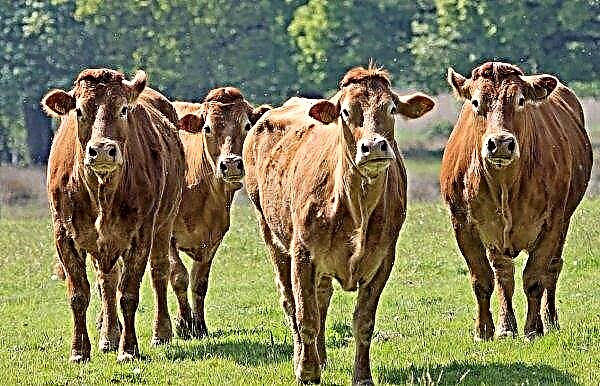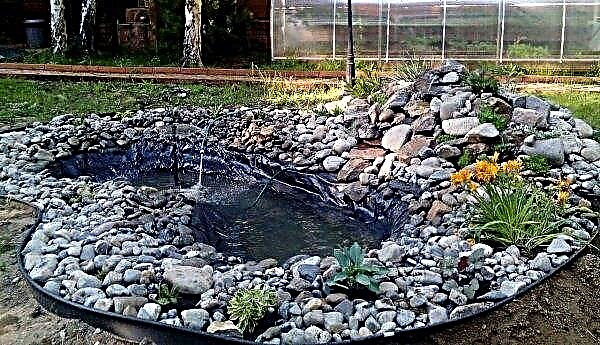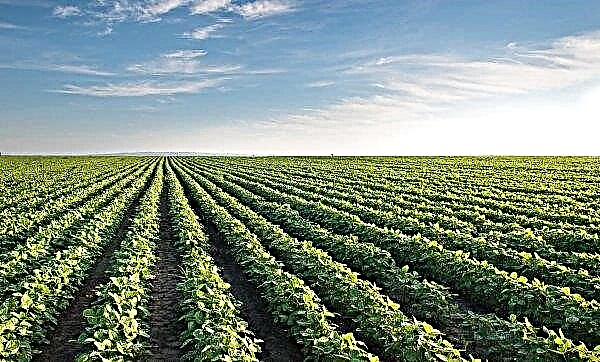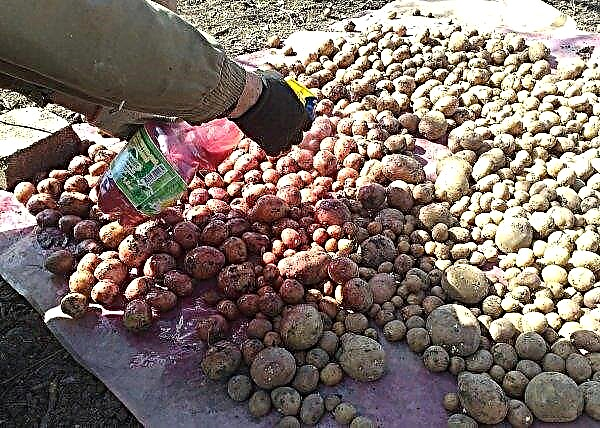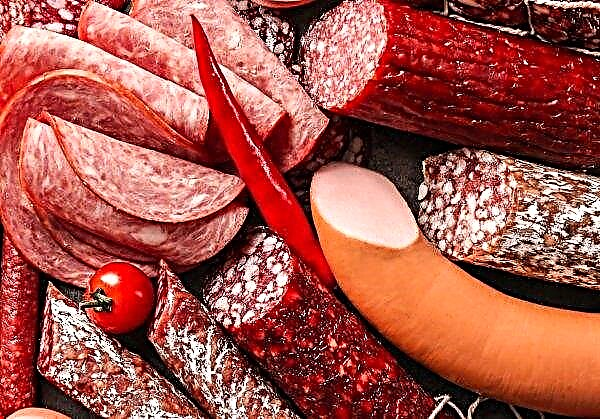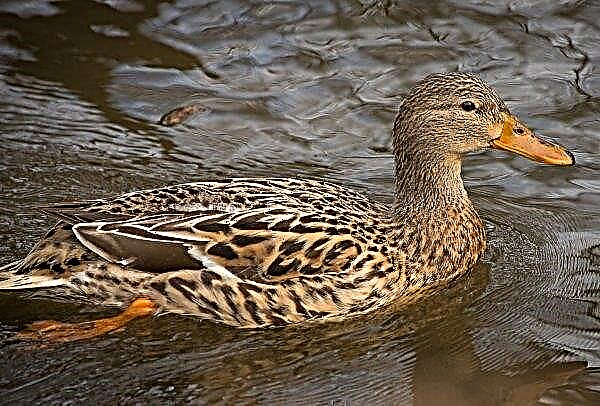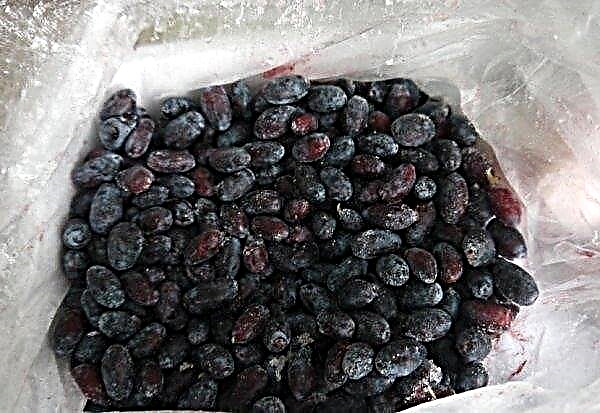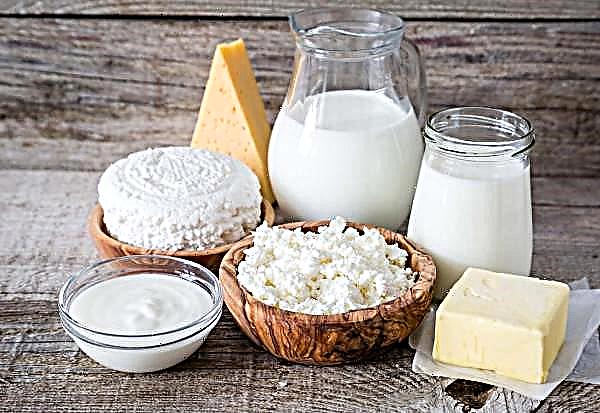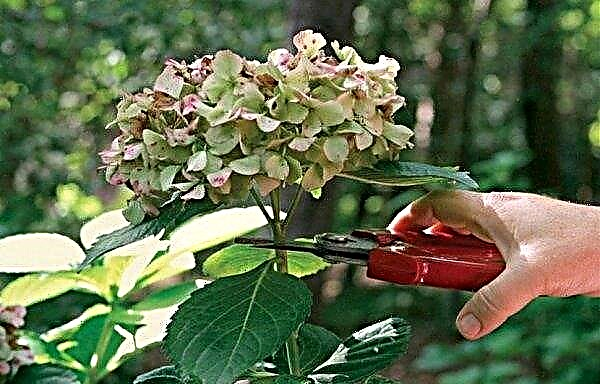Hydrangeas will add sophistication to the landscape design of any garden site. Separately, it is worth considering a new large-leaved variety Miss Saori (Latin: Hydrangea macrophylla Miss Saori), bred in Japan. In addition to attractive external data, this culture is characterized by a fairly high winter hardiness, which will be a plus for gardeners living in cool regions where not all types of hydrangeas take root.
Grade description
Hydrangea Miss Saori belongs to the U & Mi series of repair plants. Bred in 2013 by Japanese breeders. Literally in a year, she managed to fall in love with gardeners and landscape designers so much that in 2014 she won the title “Plant of the Year” at the Royal Exhibition held in Chelsea.
The considered varietal unit is a large-leaved shrub of spherical shape. Its height is 100 cm, the diameter is similar. The shoots are long, green, erect, highly branching. The foliage is large, egg-shaped, pointed at the ends, serrated on the edge. It is painted in saturated green color with a violet shimmer. The hue persists throughout spring and summer. In autumn, the color of the leaves changes to reddish.
This plant is different from other hydrangy macrophiles. Firstly, the repairant Miss Saori is able to form inflorescences on the shoots of the current and past years, which is unusual for large-leaf forms. Second a distinctive feature of the plant is that it does not change the color of the flowers when the acidity of the soil changes, which is typical for most hydrangeas of this species. The flowers are large, reaching a diameter of 5–7 cm. Collected in large inflorescences up to 30 cm in size. The petals are terry, dull, of a soft pink color with a dark red border around the edge. This color scheme looks very interesting.
The flowers are large, reaching a diameter of 5–7 cm. Collected in large inflorescences up to 30 cm in size. The petals are terry, dull, of a soft pink color with a dark red border around the edge. This color scheme looks very interesting.
Also, the variety has a long flowering period. If in the vast majority of varieties it lasts up to 3 weeks, then Miss Saori enters this phase in mid-July, and leaves it around October 10-15.
The variety develops better in areas protected from drafts. Prefers partial shade. Like all varieties of hydrangeas, the specimen in question is demanding on the quality of the soil. It grows well on loose, drained, moderately moist substrates with high acidity. It vegetates poorly on calcareous soils. And on alkalized soils suffer from chlorosis (iron deficiency).
Winter hardiness of hydrangea
The variety under consideration is characterized by a fairly high winter hardiness. This makes it possible to cultivate hydrangea in the middle lane and more northern regions of Russia. But this is only possible with winter shelter. Plants tolerate frosts to -26 ° C.
Planting and Care for Miss Saori Hydrangea
The key to lush flowering in the future is the proper planting of plants and the creation of favorable conditions on the site. All actions must be performed based on information about the botanical features of hydrangea.
Planting material should be bought in nurseries with a good reputation in order to avoid the risk of acquiring a non-varietal plant. Two-year-old seedlings take root best in a new place. Sell them in pots.
When choosing, it is worth paying attention to the following points:
- shoots - there should be 2 or 3 lignified and the same amount of grass;
- leaves - evenly colored, without signs of damage and stains;
- the root system is well developed, not protruding from under the upper soil layer.
Important! Hydrangeas will develop better if they are planted next to conifers. The shadow and plant litter from evergreen species will help ensure the most favorable conditions for the growth of hydrangeas, and in addition, such a combination will be beneficial to look on the territory.
Selection and preparation of the landing site
First, a site for plant cultivation is selected. This area should be located in partial shade or under diffused sunlight. Usually, planting is carried out in the spring, approximately in mid-April - early May, when there is no risk of return frosts. And soil preparation begins in the fall.

To begin with, they dig it to a depth of 40 cm, and then nutrients are introduced - to achieve the optimal level of acidity and friability. For each 1 m² of area, 20 kg of substrate from coniferous forest, 10 kg of sand and the same amount of peat are consumed. Then the site is again dug up to the same depth as the first time.
Landing rules
Plants should be placed on the site at a distance of at least 1.5 m from each other. If you plan to use hydrangeas as a hedge, then the step between them can be reduced to 1 m.
Instructions for planting plants in open ground:
- Abundantly water the seedling a day before moving to open ground.
- Dig a hole that exceeds the volume of the container in which the plant is located, 3 times.
- Cover the bottom of the pit with expanded clay. This layer should take a height of 15 cm indentation.
- On top of the drainage, place 5 cm of the substrate mixed with 1 cup of superphosphate, 30 g of potassium sulfate and the same amount of ammonium.
- Carefully remove the seedling from the pot, trying not to destroy the earthen lump, and with it put the plant in the pit.
- Fill the void with earth. It is important to ensure that the root neck is at the same level as in the container.
- Seal the trunk circle, pour 5 l of water at room temperature into it and mulch with compost to a height of 5 cm.

Watering and feeding
The most important agrotechnical measure in the care of hydrangea of the variety in question will be watering. The soil must be constantly kept moist. For this, in dry periods under each bush, 20 l of water are added once a week.

If there is a sufficient amount of precipitation, then the multiplicity of manipulations on moistening is reduced to 1 time per month. In the fall, watering is not stopped. The last time water is brought under the bushes 2 weeks before the cold snap.
Fertilize plants begin a year after planting. In the spring, after the convergence of snow, 20 g of nitrophoska is placed in the near-stem circle of each bush. The drug is closed to a depth of 5 cm. Nitrophos can be replaced with liquid mullein. He is bred with water 1:10. Under each bush, pour 10 liters of liquid.
The following top dressing is carried out at the time of bud formation, i.e., approximately at the beginning of July. At this stage, a solution of potassium humate, which is made according to the manufacturer's instructions, and 20 g of superphosphate are mixed.Important! To preserve moisture, nutrients in the soil and reduce the risk of the spread of a large number of weeds, you need to regularly update the settling layer of mulch. For this purpose, you can use not only compost, but also needles or moss.

The third top dressing is performed 2 weeks after the second, i.e. at the beginning of flowering, using a slightly pink solution of potassium permanganate. Such a fertilizer will help not only increase the decorative qualities of the plant, but will also serve as a preventive measure for the development of diseases and the spread of pests.
After flowering, in parallel with watering, spend the last top dressing of the season. For each plant, a solution of 10 l of water is made, in which 40 g of superphosphate and 10 g of potassium salt are dissolved.
If it is not possible to devote so much time to fertilizing plants, then you can use ready-made formulations intended for hydrangeas and rhododendrons. They are also called sustained-release top dressing.
When choosing complex fertilizers, you should pay attention to the following brands, which are popular among gardeners:
- "Fertika" - the company produces liquid and granular formulations. The first option is applied every 2 weeks, and the second - 1 or 2 times per season.
- "Pokon" - offers customers long-acting fertilizers that are applied only in the spring.
- "GreenWorld" - produces nutrition for hydrangeas and rhododendrons. Use it once every 3 months.
Video: When and how to fertilize hydrangea
Trimming hydrangea large leaf Miss Saori
When growing hydrangeas of this variety, sanitary and stimulating pruning should be performed. The first manipulation involves the removal of dried, crossed, shoots growing inside the bush, and the second is the reduction of branches without flower buds to the first healthy one.
6 years after planting, anti-aging pruning begins. They suggest the removal of old shoots under the root, on which there are no flower buds at all. In a year, no more than three such branches can be eliminated so that the plant does not suffer from excessive loss of juice.Regardless of the type of procedure, it is better to carry out it in the spring, after the shelter is removed. It is also necessary during the season to immediately remove fading inflorescences from plants.
Pruning is carried out using a well-sharpened secateurs, which must be disinfected with alcohol. Immediately after the end of the manipulation, the sections are treated with Fundazolum (wound surfaces need to be powdered). Then cover them with garden var.
Winter preparations
In order for Miss Saori hydrangea to endure the winter well and continue to delight the gardener with lush flowering, it must be properly prepared for the cold.
The main activities aimed at preserving plants from frost:
- 2 weeks before the cold snap, carry out the last watering and fertilizer (if prolonged action complexes are not used).
- When the temperature drops to 0 ° C, spruce bushes to a height of 15 cm with compost mixed with peat 1: 1. Spread between the branches of the spruce branches.
 1- tilted shoots, 2 -cocking, 3- spruce branches, 4- lutrasil, 5- stone
1- tilted shoots, 2 -cocking, 3- spruce branches, 4- lutrasil, 5- stoneThe above manipulations will be enough to fully preserve adult plants throughout the winter in the middle lane. Bushes that have not reached the age of 5 years old will need to be covered with lutrasil on top. So that the material does not slip, it is pinned to the ground with metal brackets. When cultivated in the northern latitudes, shelters require not only young specimens, but also old ones.
Diseases and Pests
In order to prevent diseases and the spread of pests in the current year after planting, the last watering is carried out at the end of the season with the addition of the drug “Fundazol”. To 1 liter of water add 1 g of powder. A year later, in the same period, “Fitosporin” is used instead of the indicated drug. To 2 liters of water add 1 tsp. liquids. So alternate drugs annually.

If you do not neglect this measure of protection and carry out all the care procedures in the correct mode, you can completely eliminate the risk of developing diseases and the spread of harmful insects. Under adverse weather conditions or improper implementation of agricultural measures, infection with fungal infections can occur.
The most common lesions are:
- Septoria
- powdery mildew;
- peronosporosis;
- gray rot.

If these problems occur, it is necessary, first of all, to cut off all damaged parts of the plant, powder the cuts with Fundazol and close with a garden var. Then remove the mulch completely and change to a new one. After that, spray on branches and soil with 1% solution of copper sulfate. During the season carry out 3 treatments with an interval of 21 days.
Did you know? Types of treelike and panicled hydrangeas are used to treat diseases of the genitourinary system, and also as a sedative. Apply leaves, roots, flowers and seeds.
Of the pests for this variety are dangerous:
- aphid;
- spider mite.

To control pests, you can use tobacco dust. Previously, the plants are exempted from damaged branches, then the mulch layer is changed. Only after this, branches and soil around the bushes are dusted with the indicated agent.
Breeding
When the site already has flowering hydrangeas of Miss Saori variety, you can think about their reproduction at home. This is best done with the help of cuttings or cuttings from the mother bushes. Both methods are highly effective and easy to perform. The option of propagation by seeds is also possible, but it is used very rarely due to the high complexity of implementation.
Cuttings
Planting material is cut when hydrangeas begin to form buds. Take growths with a large number of powerful kidneys. Cuttings cut from two-year-old shoots have a higher degree of survival.
The algorithm for the propagation of hydrangeas using cuttings:
- The trimmed stalk is divided into fragments about 10-15 cm long. Each should have 2-3 buds. The lower part of the cuttings is exposed, removing the leaves completely, and also make a cut at an angle of 45 °. At the top of the planting material, the greens are shortened to half.
- Cuttings are placed in a solution of growth accelerator for 2 hours. The type of drug does not matter, you can take any available on the farm.
- Landing raw materials are immersed in previously prepared soil, in separate containers. Make a soil mixture in a ratio of 2: 1, combining peat and sand. Before planting, they necessarily spill the earth with a weak pink solution of potassium permanganate.
- Pots with cuttings put in the garden, at partial shade. They are watered throughout the season, keeping the soil constantly moist.
- About a month later, the first rudiments of the leaves appear on the sprouts. This means that the material is already rooted.
For the winter period, seedlings are not cleaned indoors. They are sprinkled with several layers of plant litter, covered with spruce branches, and a frame is built on top (you can buy ready-made). Agrofibre is placed on it. After the risk of return frosts disappears, it will be possible to transplant the plants on the bed for growing, and after a year - to place hydrangeas in a constant place.
Layering
This method of reproduction is best done in early spring, when shelter is removed from the plants.
Algorithm of propagation of hydrangeas by layering.
- Loosen the soil around the plant. Organize trenches 2 cm deep.
- Choose powerful branches located as close to the ground as possible.
- Place planting stock in recesses. Pin branches with staples so that they do not slip out of the ground. Sprinkle layering with a mixture of peat and compost (1: 1).
- Throughout the season, take care of the planted material as an adult plant.
- At the end of summer, several growths will form on each layering. As soon as they reach a height of 15 cm, it is necessary to carry out an earthing up to the first leaves from below. Further, this procedure is carried out weekly until the elevation is 20 cm.
- In October - to separate the layering from the mother plant, dig, divide into fragments according to the number of shoots. To get the received "seedling" for the winter. To do this, make a pit 20 cm deep, put seedlings there, sprinkle them with a layer of foliage, then cover with lapnik.
- In spring, dig up potential plants. Plant on a bed for growing.
- After a year, move the seedlings to a permanent place.
The Miss Saori hydrangea variety described above can be the gem of any garden. This plant has a beautiful appearance and is not too essential to care for. When cultivating it, the most important thing is to take care of creating favorable conditions on the site, relying on the botanical characteristics of the culture.

